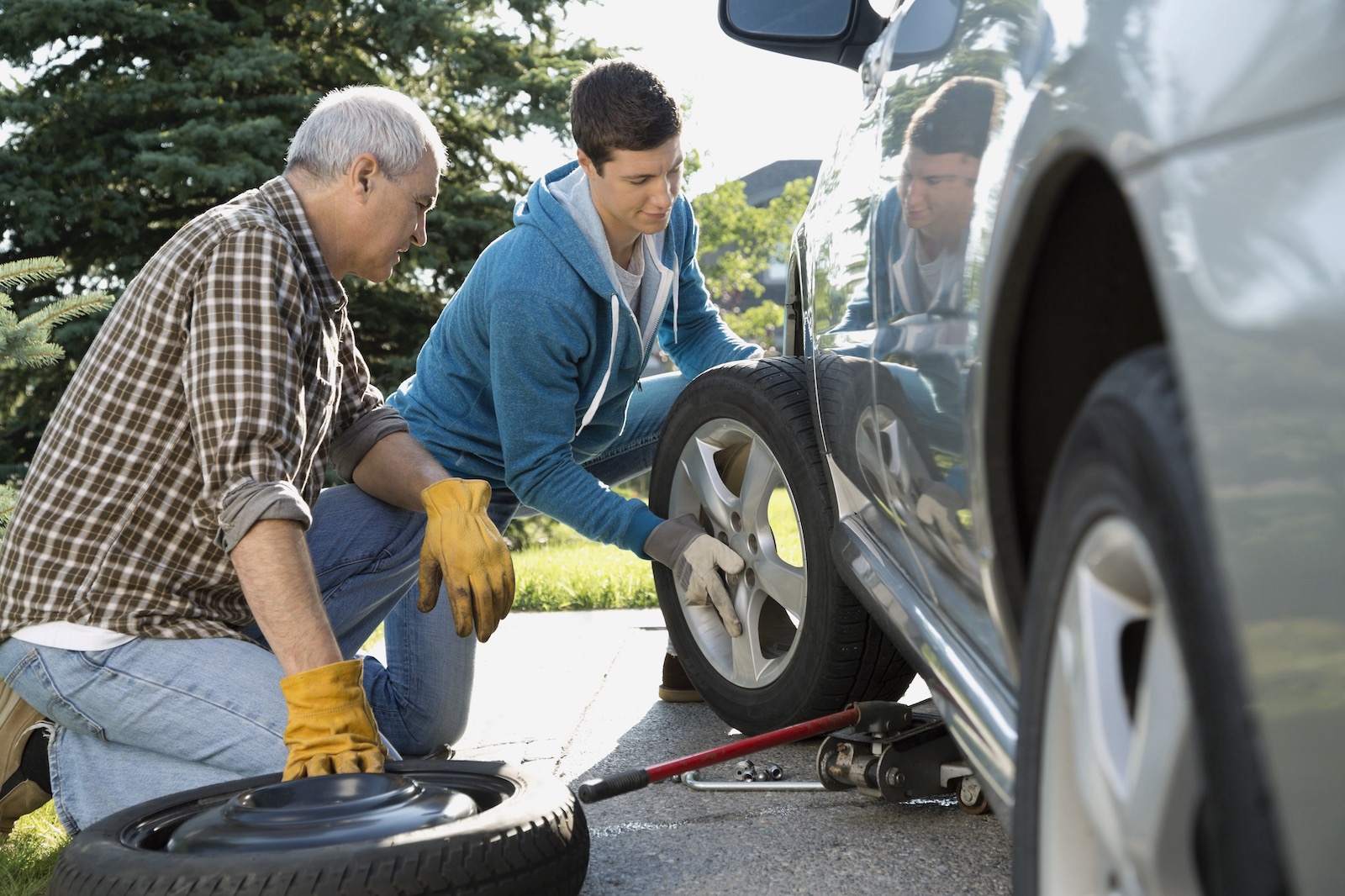Contents
What else must you know to change the tire and return to the road?
Run Flats and Other Alternatives to a Spare Tire
Flat tires are complicated, so we need to provide some caveats before getting started. First, for the most part, manufacturers seeking weight reduction no longer include a full-sized spare with the jack and lug wrench. Instead, some substitute the spare with a small, temporary tire that is good only for about 50 miles. Others do away with the spare entirely and include a can of tire sealant and a small compressor. Unfortunately, these setups aren’t always practical.
The other frequent option is to equip the vehicle with run-flat tires as original equipment. These tires allow the driver to limp home on the damaged tire. However, the tires are expensive to replace when the first set wears out and often result in an overall rougher ride.
Sealant Kits
These kits may be already on your car, or they can be purchased from eBay. The basic idea is that the pressurized can is attached to the tire’s valve stem, and then the sealant is sprayed around the tire’s interior to seal the hole. After that, the compressor pumps it full of air again.
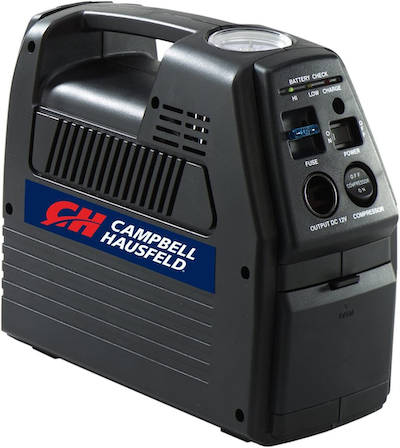
Campbell Hausfeld portable air compressor
eBay offers pressurized cans, liquid tire sealants, and tire sealant kits that include the compressor. Or you can buy a portable air compressor separately. Sealants and kits are not expensive, and the cheapest units should be avoided.
These kits work only for small tread cuts of less than six millimeters in diameter and should never be used to try to fix sidewall damage. Some kits can damage the tire pressure monitor sensor (TPMS), so check to make sure your product is TPMS-safe.
Shop now for tire sealantIf the flat-tire kit in your car is old or non-existent, eBay is here to help with these products:
- Liquid and pressurized-can sealants
- Tire repair kits
- Tire jacks and jack stands
Prepare Ahead of Time
Let’s assume your car has a full-sized spare, a jack, and a lug wrench. In this case, changing a tire can be a relatively straightforward process.
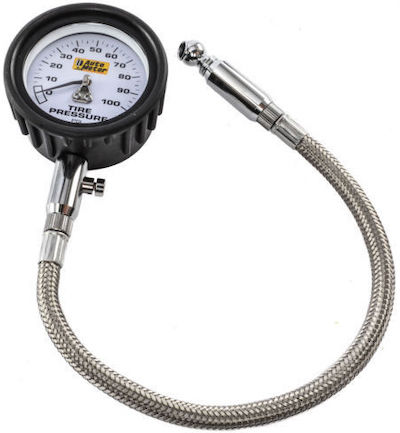
Auto Meter tire pressure gauge
The steps will only work if your spare tire is inflated. If it’s been sitting in the trunk for years without attention, it might not be. It’s a good idea to check the air pressure in your spare every other oil change. Those small temporary donut spares typically hold 60 psi.
In most cases, the spare and jack are stored together in the trunk under the floor mat, but this isn’t always true. Sometimes they’re mounted up front (especially in rear-engine cars). With luck, you won’t have to move a lot of stuff—ski equipment, Goodwill shipments, overdue library books—that are in the way and negatively impacting fuel economy. Now’s the time to ensure you have all the parts necessary to change a tire.
Shop now for donut sparesRegardless, you will need these items:
- Spare wheel – This needs to have a legal, inflated tire. Check your spare regularly to ensure it’s fully inflated and in good working order.
- Vehicle owner’s manual – It’ll have instructions specific to your vehicle, such as where to attach the jack.
- A jack – Ideally, the manufacturer’s jack is designed for your car and included in the roadside kit.
- Wheel brace or wrench – Ensure this fits the wheel nuts or bolts.
- Locking wheel nut key – If your car has locking nuts or bolts, you (or a mechanic) will need the key to undo them.
- Alignment tool – Some cars with wheel bolts have an alignment tool to help you fit the wheel.
- Wheel chocks or wedges – These should be in the kit with your spare wheel. If not, use blocks of wood or similar.
- Gloves – It’s a dirty job, and there’s a risk of cutting yourself, especially if your old tire is badly damaged.
Setup is important. Follow these rules:
- If you’re by a highway when the flat occurs, engage your hazard flashers.
- If you’re in a parking lot, don’t try to change the tire if the parking lot isn’t level or almost level.
- You can slowly move the vehicle a short distance to a better place.
- If you are on an incline, use wheel chocks/jack stands to hold the car in place. Set the parking brake or put something under at least one of the tires that is still on the ground to prevent the vehicle from moving unexpectedly.
Finally, Time to Change the Tire
Now, it’s time to remove the spare tire, the jack, the lug wrench, and the special lock nut socket (where applicable). Sometimes there will be a glossy sticker in the trunk telling you where they are and how to access them. Your owner’s manual will tell you where they are and how to use them.
Put the Jack in Place
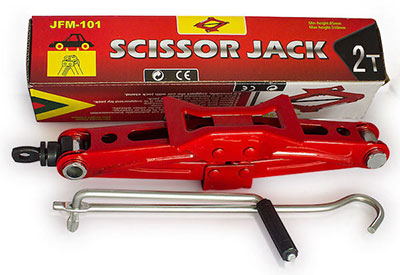
Scissor jack
Vehicles have a notched jacking point (indicated in the owner’s manual) to contact and lift the vehicle. If the vehicle has a frame, the jack should be placed under the frame. Do not put the jack under the body if the vehicle has a frame because the body won’t support the weight, and you’ll bend the metal.
Before you jack the vehicle up, remove the hubcap or cover and use the lug wrench to loosen the lug nuts, but don’t remove them yet.
Shop now for automotive jacksJack the vehicle up high enough to get the tire off and the replacement tire back on. If you raise the vehicle just high enough to get the flat tire off, you may find that you need to raise it higher to get the non-flat tire back on. Raise it enough the first time to avoid this scenario.
Remove the Flat Tire
With the wheel off the ground, finish removing the lug nuts. It’s best to put them in a container or in the vehicle’s center console. Next, remove the flat tire and lay it aside safely so you won’t trip over it.
Swap in the New Tire
Work the replacement tire onto the lug studs (this can be tricky) and slide it on so that the studs protrude enough to start the lug nuts. Screw every lug nut in as far as you can with your fingers. Then, using the lug wrench, gently snug the nuts while the car is still jacked up. Do not fully tighten at this point.
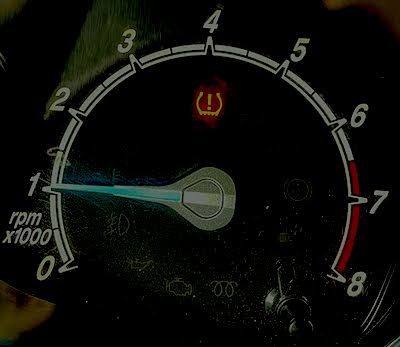
TPMS indicator light
Slowly lower the car until it’s fully back on its wheels, and remove the jack. Tighten the lug nuts as firmly as you can. Put the spare tire and the tools back in the vehicle.
The TPMS system may light up on vehicles without a sensor in the spare tire, so be aware of that. Most TPMS systems can’t be reset by the car owner. Just get back on the road, get the flat tire repaired or replaced, and have the tire store put the original wheel back on the vehicle and reset the TPMS. If you need a new wheel, a wide selection is available on eBay Motors.
Important Warnings
If a shop used a torque wrench to tighten your lug nuts—and they were overzealous—getting the bolts to turn could be challenging. Make sure you know which way the nuts tighten. Usually, but not always, it is clockwise or in a star pattern.
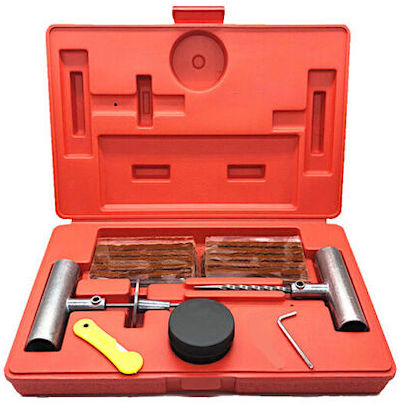
Tire repair kit
This part is critical. If the vehicle is a small front-wheel-drive type and the spare is a “donut,” the donut spare should always be placed on the rear to prevent expensive damage to the gears in the final drive part of the transaxle. If the front tire is flat on a small front-wheel-drive vehicle, you’ll have to remove a rear tire first and put the donut there, then replace the front flat tire with the non-flat tire you removed from the rear.
Shop now for tire repair kits

